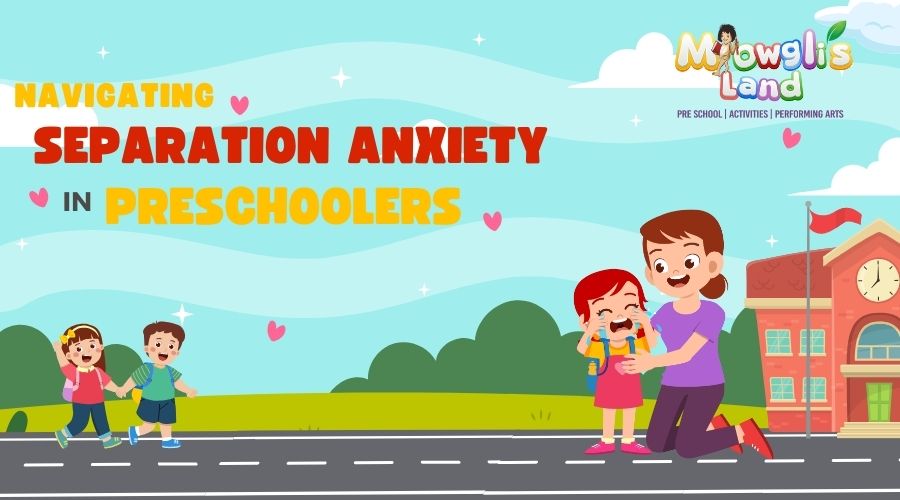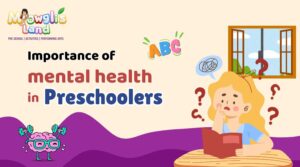Is your preschooler struggling with separation anxiety?
Losing their parent or loved one can be overwhelming for children, leading to clinginess, tantrums, and even physical symptoms like stomachaches and headaches. As a parent, worrying and feeling guilty about leaving your preschooler during these difficult moments is natural.
It’s a common challenge for children in this age group, but there are ways to help them navigate it easily. In this blog, with the best preschool in Bhopal, we’ll explore effective strategies to make the transition smoother for you and your little one!
What is Separation Anxiety?
Separation anxiety is a natural and common occurrence in the lives of preschoolers. The idea of being separated from their primary caregivers is particularly challenging. They may worry that something bad will happen to their parents or that they will be abandoned and never see their loved ones again. The child’s incapability causes these concerns to communicate their feelings effectively.
It’s important to understand that this abandonment is a normal part of a child’s emotional development and that it’s a sign of a healthy attachment between the child and their parents. By recognizing the signs and causes of separation anxiety, parents can better support their children’s needs and help them navigate this with empathy and understanding.
Signs and Symptoms
Separation anxiety in preschoolers can manifest in a variety of ways, both physically and emotionally. Some common signs and symptoms include:
- Excessive crying, clinging, or refusing to leave their parent
- Tantrums or meltdowns during separation
- Physical symptoms such as stomachaches, headaches, or nausea
- Difficulty falling asleep, or focusing on tasks when separated from their caregivers
By recognizing the signs and symptoms, parents can better understand their child’s needs and develop strategies to help them cope with these difficult emotions.
Causes of Separation Anxiety in Preschoolers
1. Attachment to Parent
Preschoolers have a strong need for emotional and physical closeness with their parents. This can lead to separation anxiety when that connection is discontinued.
2. Environmental or Routine Changes
– Starting a new school
– Moving to a new home
– Major life events (e.g., birth of a sibling or loss of a loved one) These changes can disrupt a child’s sense of security, triggering separation anxiety.
3. Personality Traits
Some children are naturally more sensitive or anxious, making them more prone to separation anxiety. A child’s age, gender, and previous experiences with separation can influence the duration of this abandonment.
4. Normal Developmental Stage
Separation anxiety is a common and normal part of a child’s development. With the right support and strategies, preschoolers can learn to manage these feelings and develop emotional resilience.
Also Read: Top 6 indoor activities for kids to try amid the monsoon
Strategies to Ease Separation Anxiety
There are a variety of strategies that parents can use to make the process smoother for both the child and their caretakers.
Some of the approaches to ease separation anxiety are given below:
- By creating a familiar pattern of activities and interactions, preschoolers can feel more secure and prepared for when it’s time for the parent or caregiver to leave.
- Another effective strategy is to gradually introduce small separations, allowing the child to become more comfortable with being apart from their parent.
- Providing the child with a favorite toy or blanket can also help them feel comforted and secure during the separation.
In addition to these practical strategies, it’s important to validate the child’s feelings of anxiety and fear. Reassure the child that it’s normal to feel sad or scared when a parent leaves.
Preparing your Preschooler for Separation
Preparing your preschooler for separation can be an effective way to help them cope with the anxiety that can arise when a parent leaves their kids for school.
One of the most important strategies is to start small and gradually increase the duration and frequency of separations. Begin by leaving your child with a trusted family member or friend for short periods, such as 10-15 minutes, and gradually increase the duration as your child becomes more comfortable.
Next, consider creating a visual aid, such as a calendar or a countdown chart, to help your child understand the timeline of your separation and return. This can provide a sense of structure and predictability, which can be especially helpful for preschoolers, struggling with this anxiety!
With the help of these strategies, you can help your preschooler feel more prepared and confident during separations. This ultimately reduces the intensity and duration of their distress.
Professional help for severe Separation Anxiety
While separation anxiety is a common and normal part of a preschooler’s development, there are times when the anxiety may become severe. If your child’s separation anxiety is disrupting their daily life, it may be time to seek professional help. In this case, a licensed therapist, such as a child psychologist or child counselor, can provide a comprehensive assessment of your child’s emotional and behavioral needs.
During the assessment and treatment process for separation anxiety, the therapist may work with you and your child to identify the underlying causes of this abandonment and develop coping strategies and relaxation techniques.
It’s important to remember that seeking professional help is not a sign of failure as a parent. It’s a responsible step that can make a huge difference in your child’s overall well-being.
By working closely with a qualified professional for mental health issues, you can empower your preschoolers to overcome their anxiety and develop emotional skills!
Conclusion
Undoubtedly, Separation anxiety is a challenging and emotional experience for both preschoolers and their parents. By understanding the signs, and causes and implementing effective strategies, you can help your child navigate this transition with ease.
With Mowgli’s Land, you can very smoothly navigate this challenging phase and help your preschooler emerge with flying colors!




